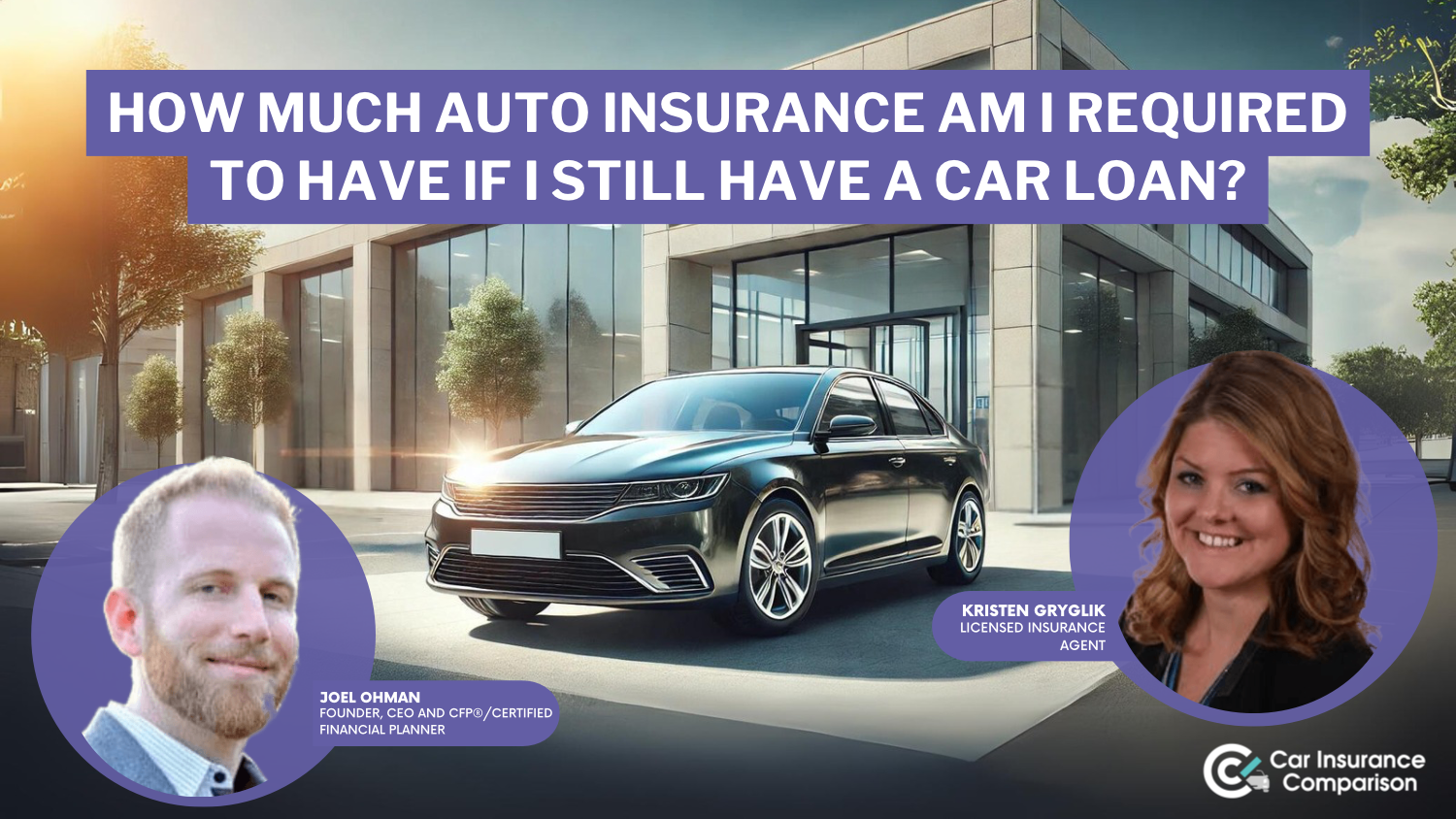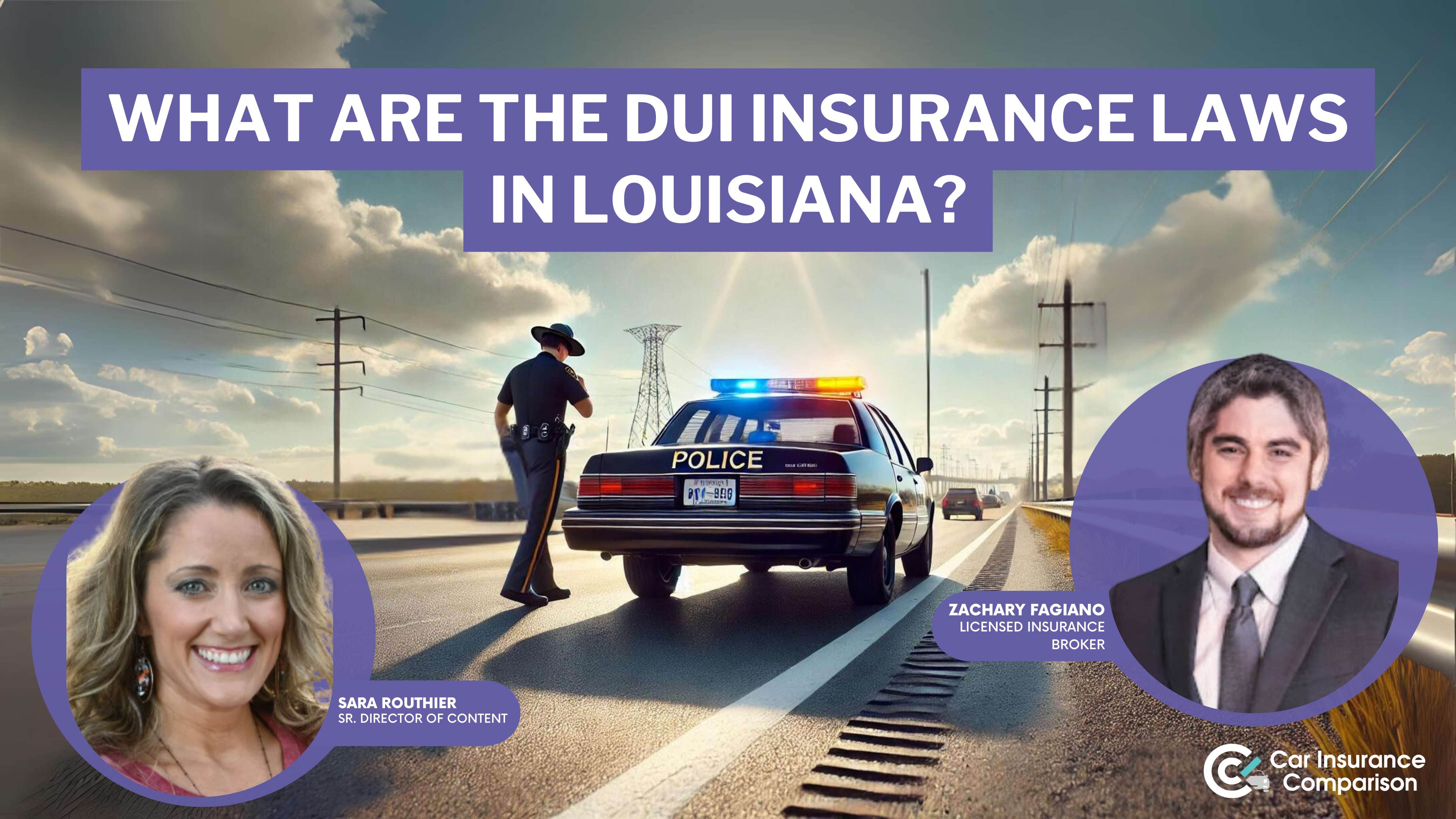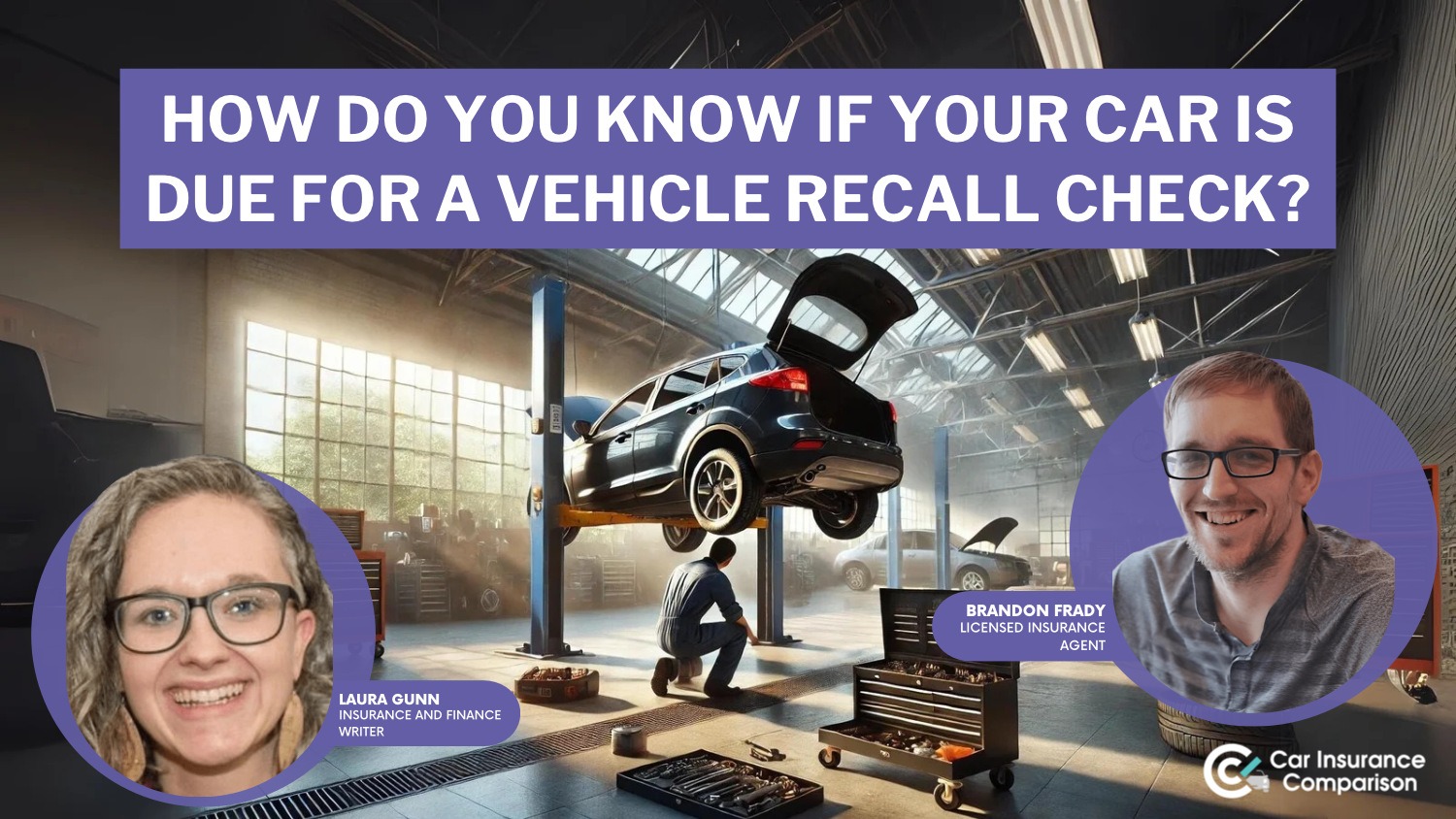How much car insurance am I required to have if I still have a car loan?
There are a few factors that affect how much insuring a financed car can cost, including how much coverage you're required to have by the state you live in, and the value of your vehicle.
Read more Secured with SHA-256 Encryption





Table of Contents
Table of Contents


Certified Financial Planner
Joel Ohman is the CEO of a private equity backed digital media company. He is a CERTIFIED FINANCIAL PLANNER™, author, angel investor, and serial entrepreneur who loves creating new things, whether books or businesses. He has also previously served as the founder and resident CFP® of a national insurance agency, Real Time Health Quotes. He has an MBA from the University of South Florida. Joel...
Joel Ohman


Licensed Insurance Agent
Kristen is a licensed insurance agent working in the greater Boston area. She has over 20 years of experience counseling individuals and businesses on which insurance policies best fit their needs and budgets. She knows everyone has their own unique needs and circumstances, and she is passionate about counseling others on which policy is right for them. Licensed in Massachusetts, New Hampshire,...
Kristen Gryglik
Updated October 2024
Usually, you only need to have enough auto insurance to meet the state’s requirements. However, if you’re insuring a financed car, your lender may want additional coverage.
Lenders want to protect their assets until you finish paying the loan. Your lender will write their minimum requirements into your contract, but usually, lenders just want a full coverage policy. Keep reading to find out what full coverage means, how much it costs, and how you can save money on car insurance.
- Most auto loan lenders require you to have full coverage auto insurance, which includes liability, collision, and comprehensive coverage
- Full coverage costs $148 per month on average
- Once you pay off your car loan, you can take coverage into your own hands
Why do lenders require full coverage if I still have a car loan?
The lender still technically owns your car while you’re paying off your loan, and they want to protect their investments.
Plus, without the proper insurance, you could get into an accident or make a claim that you can’t afford. State minimums often aren’t enough to cover your own damages, so lenders require full coverage to make sure you can still pay your monthly bill.
Free Insurance Comparison
Compare Quotes From Top Companies and Save
Secured with SHA-256 Encryption
How much does it cost to insure a financed car?
Although the minimum liability coverage rates average around $64 per month, the average full coverage policy costs about $148 per month.
Average Monthly Minimum and Full Coverage Car Insurance Rates for Four Top Companies
| Insurance Company | Minimum Liability Coverage Rates | Full Coverage Rates |
|---|---|---|
| $59 | $145 | |
| $68 | $180 | |
| $77 | $199 | |
| $116 | $295 |
However, your rates can vary greatly based on a number of factors, such as:
- Your driving record- Insurers offer cheaper rates to drivers who have clean records.
- Your location- Full coverage costs vary from state to state. Full coverage rates in New York can be $250 per month, but in Maine, they’re only $73 per month.
- Your vehicle- If you’re looking to save money, sign a loan on a car that’s used, popular, and equipped with safety features.
- Your demographics- Younger drivers, especially teenagers, are subject to the highest rates. Additionally, men get higher rates than women.
When you start shopping around for full coverage, keep those four things in mind. However, there are other factors that affect car insurance as well, including moving, being involved in accidents, or positive situations such as improving your driving record.
What is full coverage?
Many insurance companies define “full coverage” differently. More often than not, though, full coverage includes these basic types of insurance.
Liability Coverage
Liability car insurance coverage is the one type of insurance that nearly all states require. If you cause an accident, your liability insurance will help cover the victim’s expenses.
Liability includes bodily injury and property damage. Bodily injury coverage can help pay for medical expenses and legal fees if you get sued. Property liability can cover damages to the victims’ car and their belongings.
If the expenses go beyond your liability limits, you’ll have to pay the difference out of pocket. Sometimes, the state minimum is not enough for your lender, so you may have to increase your liability amounts as part of your contract.
Liability insurance does not cover your own injuries or property damages. You will need additional coverage for yourself.
Collision Coverage
If you get into an accident, a collision policy can cover the damages to your car. With a collision policy, it doesn’t matter who’s at fault. Insurance will still cover damages up to your limits, minus a deductible.
Collision insurance is usually an elective coverage, but lenders usually want this as part of your full coverage package.
Comprehensive Coverage
Comprehensive car insurance coverage, which usually goes hand-in-hand with collision coverage, covers non-collision damages and losses, including from:
- Vandalism
- Fire
- Storms
- Animals
- Theft
- Falling objects
Sometimes the unexpected happens. That’s what makes comprehensive coverage so useful.
Uninsured or Underinsured Motorist Coverage
There’s a chance you could get into an accident with someone who has little to no liability coverage. If they’re at fault for the accident, they may not be able to cover your damages.
Uninsured or underinsured motorist coverage protects you from those with insufficient insurance. It can also protect you from hit-and-run damages or theft.
This type of coverage isn’t always required by lenders. However, some states, such as Mississippi, Michigan, Tennessee, and New Mexico, have a high estimated percentage of uninsured motorists. If the risk is high, your lender may require this.
What if I don’t have enough insurance?
Always check with your lender to make sure you have enough insurance. Otherwise, you could be violating your contract.
When you sign for an auto loan, your lender will tell you what types of coverage they require and what the minimum limits are. You’ll also have to list your lender on your insurance policy so that they get notified about what coverage you have and when you make any changes.
If you drop below the minimum coverage or if you let your coverage lapse, your lender could take action. Typically, they’ll start with a force-placed policy. This insurance is far more expensive and is less likely to protect you or your personal property. If you don’t pay the force-placed insurance rate, the lender can repossess your car.
Some states are stricter than others. Lenders in California, for example, keep a close eye on your loan, and if your auto coverage lapses, they could repossess your car without warning.
Free Insurance Comparison
Compare Quotes From Top Companies and Save
Secured with SHA-256 Encryption
How can I save money on insurance for a financed car?
One easy way to reduce your monthly payment is to adjust your car insurance deductible. A deductible, which can usually range between $100 and $2,000, is the amount that you pay for a claim. You have to pay your deductible before your insurance starts covering expenses.
Increasing your deductible increases your liability, but it decreases your monthly rates. It can be useful in a pinch, but make sure you figure out how much you can afford to pay out of pocket when adjusting your deductible.
What other types of insurance should I consider?
There are plenty of elective coverages that could be helpful for you while you still owe money on your car. For example, GAP insurance can come in handy after totaling a car. Let’s say you still owe $12,000 on your car loan but your totaled vehicle is only worth $10,000. That’s $2,000 you’d have to pay out of pocket.
GAP insurance can cover the difference. This type of insurance is commonly offered by dealerships but is usually more affordable through your insurer.
If you don’t have a great health insurance plan, you could also consider personal injury protection insurance or medical payments coverage to help cover medical costs after an accident.
Will my insurance go down once my loan is paid off?
Insurance companies don’t use your loan to determine your rates, so your rates won’t change automatically. However, you can easily downgrade once you pay off your loan.
First, remove your lender from your policy. Then, you can start dropping coverages that you don’t need as long as you hit the state minimums. If you live in an area that has a high risk of collisions, storm damage, or crime-related damage, you might want to consider keeping collision and comprehensive coverage.
It might also depend on the value of your car. Check out estimation tools such as Kelley Blue Book to see what your car might be worth. If your car’s value is still more than your annual insurance rates plus your deductible, keeping full coverage is well worth it.
Free Insurance Comparison
Compare Quotes From Top Companies and Save
Secured with SHA-256 Encryption
Case Studies: Required Car Insurance With a Car Loan
Case Study 1: State-Mandated Liability Coverage
John purchased a car using a car loan and his lender requires him to maintain certain insurance coverage throughout the loan term. In his jurisdiction, the state mandates a minimum liability coverage of $25,000 for bodily injury per person, $50,000 for bodily injury per accident, and $10,000 for property damage. John is required to maintain at least this minimum liability coverage as part of his car loan agreement.
Case Study 2: Lender-Required Comprehensive and Collision Coverage
Sarah financed her car through a lender who not only requires liability coverage but also mandates comprehensive and collision coverage as part of the loan agreement. In addition to the state-mandated liability limits, Sarah is also required to carry comprehensive and collision coverage with specific deductibles. This ensures that the lender’s investment is protected in the event of damage to the vehicle.
Case Study 3: Gap Insurance Requirement
Mike obtained a car loan and his lender includes a requirement for gap insurance. Gap insurance covers the difference between the car’s actual cash value and the outstanding loan balance in the event of a total loss. Mike must carry gap insurance as part of his loan agreement to ensure that he is not responsible for paying the remaining loan balance out of pocket if his car is totaled.
Case Study 4: Lender-Specific Requirements
Samantha’s lender has specific insurance requirements that go beyond the state minimums. The lender requires liability coverage, comprehensive coverage, and collision coverage with higher limits than the state mandates. Samantha is obligated to meet these additional coverage requirements as specified in her loan agreement.
The Final Word on Auto Insurance for Financed Cars
Balancing a car loan and a full-coverage plan can seem expensive, but it could save you a lot of money down the road. Once you know your lender’s specific requirements, you customize your deductibles for the most affordable rates.

Frequently Asked Questions
How much car insurance am I required to have if I still have a car loan?
You are generally required to have enough insurance to meet your state’s requirements. However, your lender may also require additional coverage.
Why do lenders require full coverage if I still have a car loan?
Lenders want to protect their investment in case of an accident or claim that you can’t afford to pay. Full coverage provides more comprehensive protection.
How much does it cost to insure a financed car?
The average cost for full coverage is around $148 per month, but it can vary based on factors like your location, driving history, and the value of your car.
What is full coverage?
Full coverage typically includes liability coverage, which is required by most states, as well as collision, comprehensive, and uninsured/underinsured motorist coverage.
What if I don’t have enough insurance?
It’s important to check with your lender to ensure you have enough coverage. If you don’t meet the requirements, your lender may take action, such as obtaining more expensive force-placed insurance or repossessing your car.
Get a FREE Quote in Minutes
Insurance rates change constantly — we help you stay ahead by making it easy to compare top options and save.




